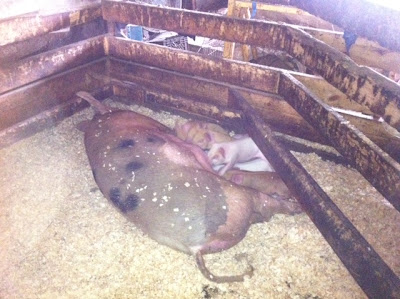The seeds are arriving and slowly piling up in the corner of my room. Meanwhile, I’ve been trying to figure out what to do with them. In order to organize the information about each plant and get ready to make a full planting schedule I’ve been putting together spreadsheets. I have a page for each vegetable and then I list all the varieties separately. Then, using the Johnny’s catalog, the Cornell Cooperative Extension website and Coleman’s The New Organic Grower, as well as a couple of other sources, I’ve been compiling important growing information.
First of all, I have to figure out what vegetables I’m going to start inside and then transplant, and what vegetables I’m going to seed directly into the garden. Some vegetable plants really have to be started inside, like the brassicas (cauliflower, broccoli, brussel sprouts and cabbage) and nightshades (tomatoes, eggplants, peppers). Luckily, the woman who owned Dave’s parents house before them had a cut flower business, and so she built a small greenhouse off the garage.
 |
| The greenhouse, the windmill and the sun this morning |
 |
| The greenhouse really warms up during the day. Even in the middle of the winter I often have to open a window to stop the temperature inside from skyrocketing past 90 degrees F |
So far I’ve just been growing lettuce, kale, swiss chard and bak choy in the greenhouse. Dave built me some tables and boxes, about 6″ deep and of various sizes, and I was able to grow a fair amount of small, yet delicious, greens over the winter. This week however, I’m going to be pulling all the soil and the boxes out of there so we can start fresh with our new potting soil and transplants for the Spring.
Next, I have to determine whether or not I’m going to be succession seeding the vegetables and, if so, how many times. For example, I’m growing 100′ (one row) of a variety of carrots called Scarlet Nantes. These carrots will grow from May 1st to July 15th, which is about 12 weeks. During those 12 weeks I’m going to want to be planting new seeds directly into the garden (carrots are difficult to transplant on account of their roots becoming irregular, plus they grow pretty quickly) every 3 weeks to ensure that I have a consistent supply of new growth. This means that I’m going to be doing at least 4 plantings, and so therefore each planting will involve seeding 25′ of the garden.
This is all getting boring so I’ll just show an example.
Each vegetable has it’s own sheet. After I’m done with the sheets I’m going to lay it all out on a MASTER calendar so I know exactly when I’m going to be planting everything, and how. Pretty exciting, right?
Meanwhile, there are a lot of other things to think about. Right now, I’m worried because we keep hearing more and more about how wet the land we’re planning on planting on is. We haven’t really looked at it critically without the snow and so we’re not sure what to expect. The moisture could be an issue because we have to wait for the area to dry off in the Spring before we can even till the land, and with all the snow outside right now it doesn’t seem like it’s ever going to be dry. All this probably means that we’re going to get a late start this year, and are going to have to rely heavily on transplants.
 |
| Right past those trees and under all that snow is the site of our future vegetable garden |
Alright, enough about the garden. Here’s some pictures of chickens!
 |
| This is the chicken coop for layers |
 |
| Their yard. I put down some hay so they can come out and walk around on the snow which they seem to love until they get too cold |
 |
| And here they are! |
 |
| Laying boxes |
Right now we have 9 laying hens and we’re planning on bumping up the number to 30 this Spring, which is about as many as we can fit in this chicken coop while still making sure they all have enough space. That’s going to involve building a couple more laying boxes, although right now they all insist on using the box all the way to the right, and have kicked all the hay out of the other two.
The hen in the laying box in this picture appears to have gone broody in the last couple of days, which means that she’s become intent on sitting on her eggs day in and day out, even if it means that she doesn’t eat or drink. This is also a problem because our delicious eggs are going bad underneath her. I’ve been reading about several ways to cure broodiness, everything from dipping their stomach in cold water (I don’t think that’s a good idea in the middle of Winter) to putting them in a cage by themselves up off the ground and away from the nest. I’ll report back later on how this problem progresses and how we manage to solve it. If anyone has any ideas, let me know.



































